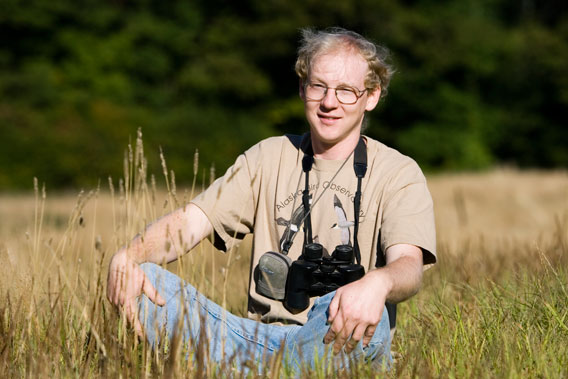For the Birds
Alexander Keyel studies declines in bird populations, and looks for ways to protect the places they live
By Robert Bochnak
With the possible exception of Homer Simpson, there are few people who can say that doughnuts played an important role in their lives. Alexander "Sasha" Keyel is one of them.

"If habitats are not protected, then many bird species will disappear, and that's a tragedy," says Alexander Keyel. Photo: Melody Ko
"Growing up, my father would take my siblings and me bird watching," says Keyel, a biology doctoral student and Provost Fellow. "I was five years old at the time, and I only went because we got to have doughnuts on the way there."
As it turns out, these trips were about more than feasting on breakfast treats. For Keyel, they marked the beginning of a lifelong fascination with birds. "As I got older, I became more interested in birds, especially while I was an undergraduate at Arizona State and started bird watching on my own," he says. "I'd see different types of birds and then look them up in a field guide."
Keyel spent most of last summer bird watching. Working for the Massachusetts Audubon Society, he observed least terns-a species recognizable by their black caps, white foreheads and yellow bills-living on the beaches of Cape Cod. Keyel monitored their behavioral patterns with the hope that the data he and his fellow researchers collected might shed light both on how the birds live and how they might be helped.
"We observed the nests to see, for example, what types of fish the terns brought back to eat," says Keyel. "In reality, many other things happened, but we wanted to focus on their foraging behavior. For another project, we visited most of the beaches on Cape Cod and counted every single least tern nest. We were interested in seeing how they were doing, whether they were increasing or decreasing in population."
For his doctoral dissertation, he plans to examine why some species of grassland birds have declined in population. "Grassland birds are abundant, but in the last 40 years some species have declined by more than 50 percent," he says, citing research conducted by the National Audubon Society. "One of the driving factors in this decline is habitat loss, and some species have been affected by this more severely than others."
Keyel, who lists the southern cassowary, the scarlet macaw and the great gray owl as some of his favorite birds, is keenly aware of the habitat challenges facing many species.
"I think it's very important to protect bird habitats," says Keyel. "Take the ruby-throated hummingbird. Each spring, many of these birds migrate from Mexico to Massachusetts. After they cross the Gulf of Mexico, they are tired. If everything on the south coast of Texas is housing developments and what-not, then they don't have an appropriate stop-over habitat, and they will die. If habitats are not protected, then many bird species will disappear, and that's a tragedy."
Keyel, whose graduate studies are being supported by a Graduate School of Arts and Sciences Scholarship, says the loss of such birds would have far-reaching repercussions.
"We don't just lose the beauty of birds, but these animals provide different functions in the ecosystem that we don't always understand. A lot of these birds eat different invertebrates which, in turn, might eat pests. Therefore, if these birds are gone, then there might be more pest outbreaks, because you will be losing the natural control of them. All of these things and more make protecting birds important."
This article first appeared in the Spring 2008 issue of Alma Matters. Robert Bochnak may be reached at robert.bochnak@tufts.edu.


